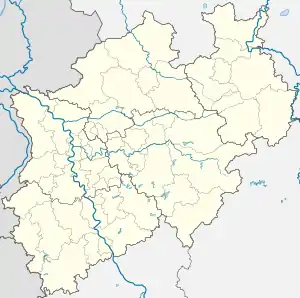Rheine
Rheine (German: [ˈʁaɪ̯nə] (![]() listen)) is a town in the district of Steinfurt in Westphalia, Germany. It is the largest town in the district and the location of Rheine Air Base.
listen)) is a town in the district of Steinfurt in Westphalia, Germany. It is the largest town in the district and the location of Rheine Air Base.
Rheine | |
|---|---|
 | |
 Coat of arms | |
Location of Rheine within Steinfurt district  | |
 Rheine  Rheine | |
| Coordinates: 52°17′N 7°26′E | |
| Country | Germany |
| State | North Rhine-Westphalia |
| Admin. region | Münster |
| District | Steinfurt |
| Government | |
| • Mayor | Peter Lüttmann |
| Area | |
| • Total | 145 km2 (56 sq mi) |
| Elevation | 35 m (115 ft) |
| Population (2019-12-31)[1] | |
| • Total | 76,218 |
| • Density | 530/km2 (1,400/sq mi) |
| Time zone | UTC+01:00 (CET) |
| • Summer (DST) | UTC+02:00 (CEST) |
| Postal codes | 48429-48432 |
| Dialling codes | 05971, 05975, 05459 |
| Vehicle registration | ST, BF, TE |
| Website | www.rheine.de |
Geography
Rheine is on the river Ems, approx. 40 kilometres (25 mi) north of Münster, approx. 45 kilometres (28 mi) west of Osnabrück and 45 kilometres (28 mi) east of Hengelo (Netherlands).
Division of the town
Rheine consists of 15 districts:
|
|
|


History
Although the region around the city has been populated since prehistoric times, Rheine was first mentioned in a document signed by Louis the Pious in 838. On 15 August 1327 it received its town charter from Louis II, Bishop of Münster.
The settlement was near to the crossing of two old merchant roads and a ford over the river Ems. Frankish soldiers initially secured this strategic point by a barrack yard. Later a church and more buildings were added to this outpost.
At the end of the Thirty Years' War the city was burned down almost completely. Swedish and Hessian troops besieged imperial soldiers who had entrenched themselves in Rheine. On 20/21 September and 19 October 1647 glowing cannonballs set fire to the city and 365 houses were destroyed.
During the industrialization the textile industry prospered. It remained an important economic factor until the second half of the 20th century. Today engineering industries and services form the largest part of economy in Rheine.
On April 1, 1927 about 10,000 inhabitants of the Office Rheine (Bentlage, Wadelheim, Dutum, etc.) were incorporated into the city, the population increased to 29,598, the city area was thus tripled.
During the Third Reich, Jewish citizens were also deported from Rheine. The allied war opponents bombarded the city repeatedly, especially the railway line and the Dortmund-Ems Canal, which represented tactical goals. The large-scale attacks on 5 October met in 1944, and 21 March 1945, each with more than 200 dead and Injured the city area. The conquest of Rheine took place on April 2, 1945 after some fierce fighting by units of the 157th British Infantry Brigade (5th Battalion of the King's Own Scottish Borderers Regiment, 7th Battalion of the Cameronians (Scottish Rifles) Regiment).
Rheine was after the war in 1945 in the British occupation zone and 1946 was politically assigned to the newly founded country North Rhine-Westphalia, which formed in 1949 with the other Western -Zonal countries, the Federal Republic of Germany.
On February 10, 1946 Rheine was affected by the highest ever Emshochwasser. Large parts of the city were flooded.
On August 15, 2002, the city celebrated the 675th anniversary of the granting of municipal law.
Mayors
- 1946–1948: Georg Pelster (1897-1963) (CDU)
- 1948–1954: Albert Biermann (CDU)
- 1954–1960: Balduin Echelmeyer (CDU)
- 1960–1961: Franz Rudolf Kümpers (CDU)
- 1961–1975: Albert Biermann (1903-1994) (CDU)
- 1975–1994: Ludger Meier (CDU)
- 1994–1999: Günter Thum (SPD)
- 1999–2004: Wilhelm Niemann (1949-2012) (CDU)
- 2004–2015: Angelika Kordfelder (born 1955) (SPD)
- since 2015: Peter Lüttmann
Twin towns - sister cities
Birthplace

- Moritz Dobschütz (1831 – 1913), German-American merchant
- Josef Winckler (1881 – 1966), German author
- Carlo Mense (1886 – 1965), German painter
- Gustav Niemann (1899 – 1982), German mechanical engineering scholar
- Josef Pieper (1904 – 1997), German philosopher
- Peter Funke (* 1950), German historian
- Oliver Krüger (* 1973), German professor of religious studies
- Jonas Reckermann (* 1979), German beach volleyball player
In popular culture
In Harry Turtledove's alternate history novel trilogy The Hot War, Rheine is the site of a 1951 battle between NATO and Soviet armies during World War III.
References
- "Bevölkerung der Gemeinden Nordrhein-Westfalens am 31. Dezember 2019" (in German). Landesbetrieb Information und Technik NRW. Retrieved 17 June 2020.
- "Die Partnerstädte". rheine.de (in German). Rheine. Retrieved 2019-11-28.
External links
| Wikimedia Commons has media related to Rheine. |